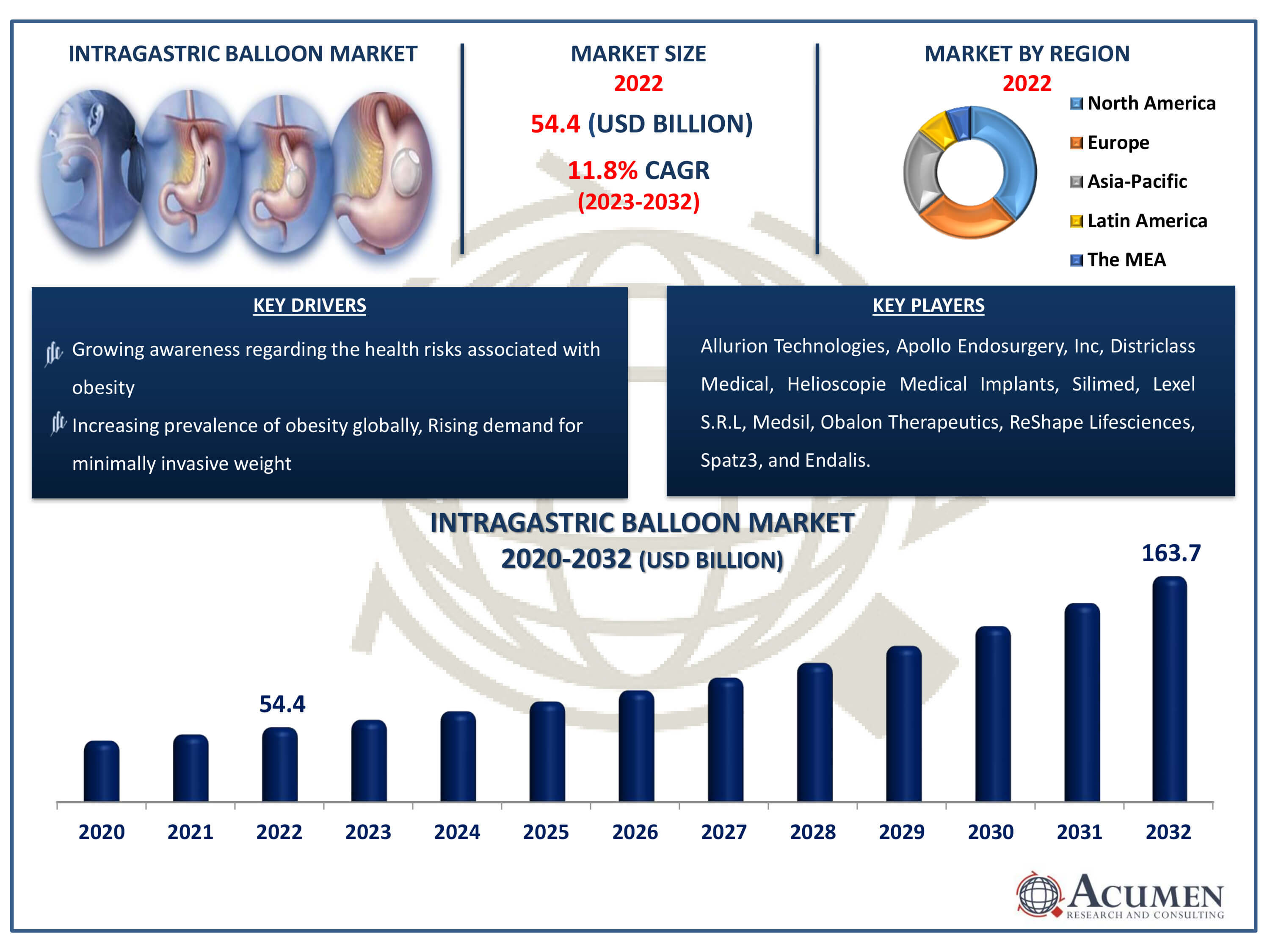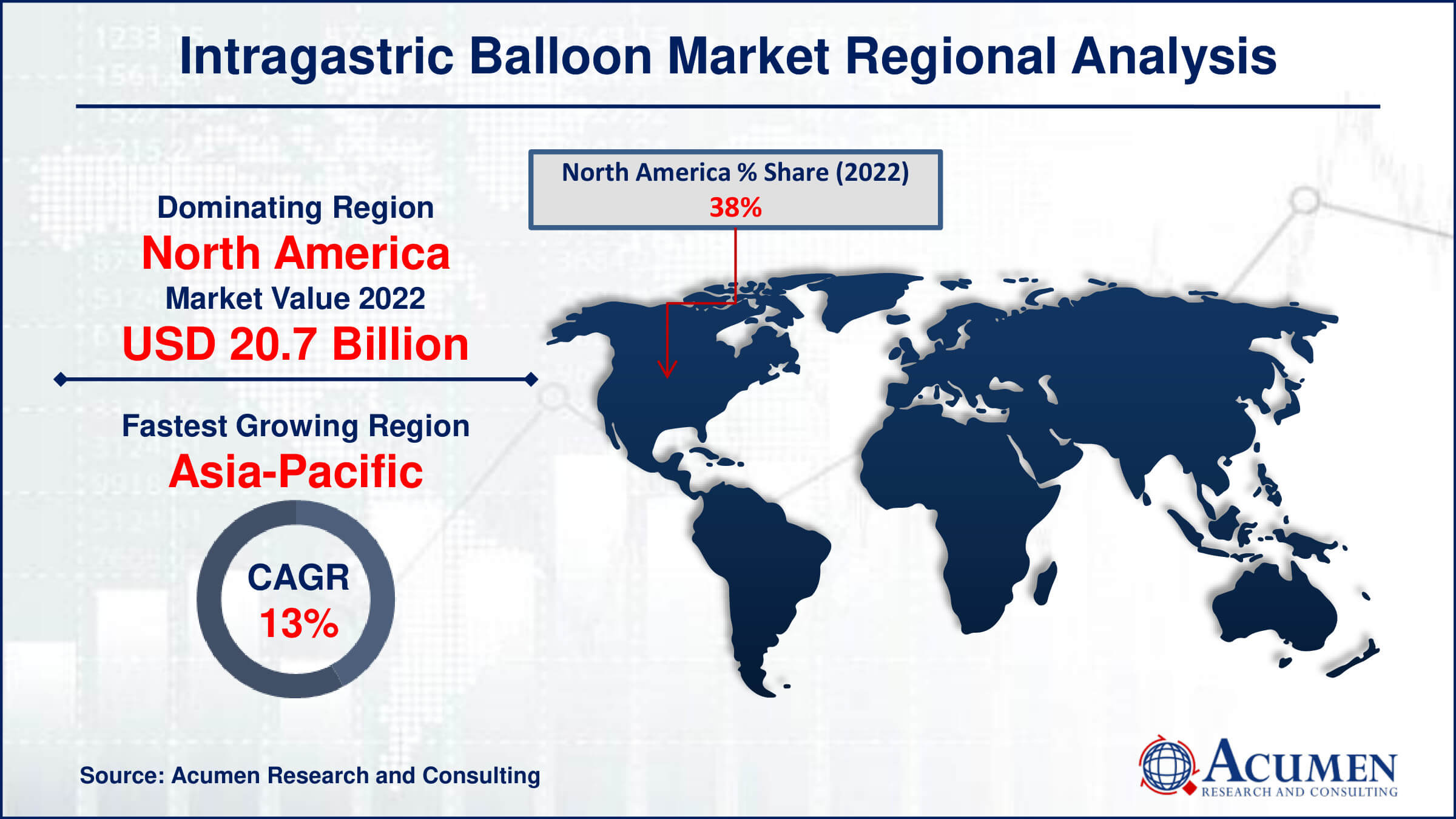February 2025
Intragastric Balloon Market Size accounted for USD 54.4 Billion in 2022 and is estimated to achieve a market size of USD 163.7 Billion by 2032 growing at a CAGR of 11.8% from 2023 to 2032.
The Intragastric Balloon Market Size accounted for USD 54.4 Billion in 2022 and is estimated to achieve a market size of USD 163.7 Billion by 2032 growing at a CAGR of 11.8% from 2023 to 2032.
Intragastric Balloon Market Highlights

A gastric balloon is a medical device that is used in an endoscopic intragastric procedure, where the inflated silicone balloon is inserted into the stomach and retained there for 6-12 months. This is widely known as a weight loss balloon designed to help individuals eat less and feel full sooner while eating. This creates less room for food and helps the body adjust to healthy portions. The procedure is non-surgical, non-invasive, and requires no incision. However, this procedure is not permanent and helps individuals to lose up to three times the weight compared to diet alone. Apart from weight loss, it has many health benefits as it helps improve diabetes, maintain cardiac health, and address other bone-related issues.
Global Intragastric Balloon Market Dynamics
Market Drivers
Market Restraints
Market Opportunities
Intragastric Balloon Market Report Coverage
| Market | Intragastric Balloon Market |
| Intragastric Balloon Market Size 2022 | USD 54.4 Billion |
| Intragastric Balloon Market Forecast 2032 | USD 163.7 Billion |
| Intragastric Balloon Market CAGR During 2023 - 2032 | 11.8% |
| Intragastric Balloon Market Analysis Period | 2020 - 2032 |
| Intragastric Balloon Market Base Year |
2022 |
| Intragastric Balloon Market Forecast Data | 2023 - 2032 |
| Segments Covered | By Administration, By Product, By Filling Material, By End User, And By Geography |
| Regional Scope | North America, Europe, Asia Pacific, Latin America, and Middle East & Africa |
| Key Companies Profiled | Allurion Technologies Inc., Apollo Endosurgery, Inc, Districlass Medical, Helioscopie Medical Implants, Silimed, Lexel S.R.L, Medsil, Obalon Therapeutics, ReShape Lifesciences, Spatz3, and Endalis. |
| Report Coverage |
Market Trends, Drivers, Restraints, Competitive Analysis, Player Profiling, Covid-19 Analysis, Regulation Analysis |
Intragastric Balloon Market Insights
The rising demand for minimally invasive surgical procedures will significantly drive the growth of the intragastric balloon market during the forecast period. A major growth driver is the reduction in post-operative trauma and complications with the use of non-surgical intragastric balloons. Other advantages associated with the use of advanced intragastric balloons across the forecast timeframe include reduced hospital stays and no blood loss. The rising prevalence of obesity is expected to enhance market growth in the near future. Major causes contributing to this trend include the adoption of sedentary lifestyles, unhealthy diets, and alcohol abuse. According to the World Health Organization (WHO), in 2016, more than 1.9 billion people worldwide were overweight, with approximately 650 million classified as obese. This high prevalence of obesity is anticipated to drive a higher adoption rate of intragastric balloons during the intragastric balloon industry forecast period.
Rising cases of obesity increase the risk of premature death from stroke, heart disease, gallbladder disease, type 2 diabetes, and some cancers. The existence of established healthcare infrastructure, coupled with a favorable regulatory scenario, will drive industry growth. Developments aimed at reducing unwanted effects such as gastric erosion, ulceration, and vomiting will foster business growth. For instance, new systems like the Spatz adjustable balloon and Reshape Duo are specially designed with antimigration properties to prevent migration and allow for balloon volume alteration. These advancements are expected to boost growth during the intragastric balloon market forecast period.
Intragastric Balloon Market Segmentation
The worldwide market for intragastric balloon is split based on administration, product, filling material, end user, and geography.
Intragastric Balloon Administrations
According to intragastric balloon industry analysis, the market is dominated by the endoscopy segment because of its widespread adoption and proven efficacy. Using an endoscope, a deflated balloon is put into the stomach as part of a non-surgical technique that creates a feeling of fullness by taking up space. Benefits of endoscopic placement include low invasiveness, a shorter recovery period, and the ability to track the balloon's exact location. Its appeal stems from its demonstrated effectiveness in managing weight and from developments in endoscopic technology that guarantee accurate placement. As a result, it is the top option for patients and healthcare professionals in the intragastric balloon market.
Intragastric Balloon Products
The orbera (single) intragastric balloon is the most popular product category in the market because of its proven effectiveness and broad acceptance. A deflated silicone balloon is inserted into the stomach and subsequently inflated to produce a feeling of fullness, which helps with portion control and weight loss. This single balloon system is a non-surgical technique. The success of Orbera is ascribed to its safety record, demonstrated efficacy in weight loss, and comparatively simple implantation procedure. Due to its popularity among patients and healthcare professionals as well as a track record of success, it is the go-to option and dominates the intragastric balloon market.
Intragastric Balloon Filling Materials
The intragastric balloon saline-filled category has the largest market share due to a variety of advantageous factors. Saline-filled balloons are designed to help with weight reduction. They are filled with a sterile saline solution and expand to occupy space in the stomach, causing a feeling of fullness. Saline is a chemical that is easily absorbed by the body and is biocompatible, which contributes to its safety profile and popularity. These balloons have also been shown to be useful in assisting with weight loss, and they may be modified if needed. Their dominance in the intragastric balloon industry is largely due to the fact that they are widely accepted by both patients and healthcare providers.
Intragastric Balloon End Users
In terms of intragastric balloon market analysis, hospitals segment is dominating because of their extensive infrastructure and resources, which enable them to provide a wide range of medical services, including cutting-edge operations like the installation of intragastric balloons. Assuring patient safety both during and after the surgery, hospitals offer a regulated setting that can manage a variety of complications. Additionally, they frequently employ specialised teams with expertise in providing all-encompassing care and controlling obesity-related problems. Hospitals prevailing position in this market segment is reinforced by the fact that patients prefer them for intragastric balloon treatments, which is mostly due to patients' trust in these facilities and the assortment of medical specialisations they offer.
Intragastric Balloon Market Regional Outlook
North America
Europe
Asia-Pacific
Latin America
The Middle East & Africa

Intragastric Balloon Market Regional Analysis
For a number of reasons, North America dominates the intragastric balloon business. The area is known for its sophisticated healthcare system, high obesity rates, and commitment to cutting-edge medical treatments. Additionally, the existence of significant industry participants and a favourable regulatory environment foster market expansion in this area. The dominance of North America in the intragastric balloon industry is partly attributed to patients' willingness to choose less invasive methods for weight management.
Conversely, the intragastric balloon market with the quickest rate of growth is found in the Asia-Pacific area. The industry is growing as a result of factors like the fast growing obesity population, rising disposable income, and improved healthcare infrastructure. The Asia-Pacific intragastric balloon market has grown significantly, which can be attributed to changing healthcare systems and increased awareness of the advantages of minimally invasive weight loss procedures. This region is positioned as an important growth frontier in the industry due to its potential for market penetration and the demand for efficient weight management solutions.
Intragastric Balloon Market Players
Some of the top intragastric balloon companies offered in our report includes Allurion Technologies Inc., Apollo Endosurgery, Inc, Districlass Medical, Helioscopie Medical Implants, Silimed, Lexel S.R.L, Medsil, Obalon Therapeutics, ReShape Lifesciences, Spatz3, Endalis, and Spatz3.
Looking for discounts, bulk pricing, or custom solutions? Contact us today at sales@acumenresearchandconsulting.com
February 2025
October 2023
November 2022
September 2022